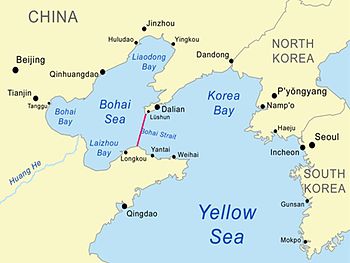Bohai undersea tunnel under serious preparation
- By Chen Boyuan
 0 Comment(s)
0 Comment(s) Print
Print E-mail China.org.cn, February 14, 2014
E-mail China.org.cn, February 14, 2014
|
|
|
A map of the Bohai Bay's undersea tunnel. [File photo] |
The Bohai Bay undersea tunnel plans are now entering a stage of serious preparation. Once completed, the distance between Dalian and Yantai will be shortened to 165 km, or 30 minutes by train.
The cities of Dalian and Yantai will be brought closer by the undersea tunnel, which, upon completion, will shorten the intercity distance from the present 1,980 km, involving a large detour, to merely 165 km.
The Bohai sea undersea tunnel project was recently listed in Chinese top transport authority's yearly reform work priorities. Once approved, the tunnel is expected to complete construction and become operational within the next 10 years.
Previous options to shorten the distance included a railway ferry line, a cross-bay strait and an undersea tunnel in order to directly connect the Liaoning Peninsular and the Shandong Peninsular. Nevertheless, a 2012 field investigation by engineering experts ruled out the first two options for reasons of unreliability. Wang Mengshu, member of the Chinese Academy of Engineering and a railway expert, said the tunnel's best advantage is its risk resistance.
Wang said the cross-bay tunnel will stretch across 123 km to both ends, beating the Seikan Tunnel in Japan, to become the world's longest undersea passage. The tunnel will have an average depth of 20 to 30 meters, though the deepest point will reach 70 meters.
According to Wang, railway trains -- with a speed up to 200 kph -- will be the main form of transport used in the tunnel to cover the distance in some 30 minutes. The commuting trains will have flatbed carriages to transport road vehicles and passengers.
In the design plans, to be handed in, Dalian's Lyushun (Port Arthur) District and Yantai's Penglai area will become the entrances on both ends of the tunnel. The project includes three paralleled tunnels: two side ones for single directional railway transport and the middle one for service and maintenance.
Earlier reports speculated that total investment would add up around 200 billion yuan (US$33.06 billion), but Wang hinted this number to be inaccurate as it remains too early to provide such an estimate. Nonetheless, Wang adjusted the number to 260 billion yuan (US$42.98 billion).
The massive investment will be recovered in the 12 years after the tunnels begins operation, since an 8 percent annual rebate is expected for this undersea passage, according to the preliminary research team.
Follow China.org.cn on Twitter and on Facebook to join the conversation.







Go to Forum >>0 Comment(s)